#stubfoot toad
Text

Purple Harlequin Toad (Atelopus barbotini), family Bufonidae, endemic to the uplands of central French Guiana
photograph by Reptiles4all
#toad#frog#atelopus#stubfoot toad#harlequin toad#amphibian#bufonidae#herpetology#animals#nature#south america
1K notes
·
View notes
Photo


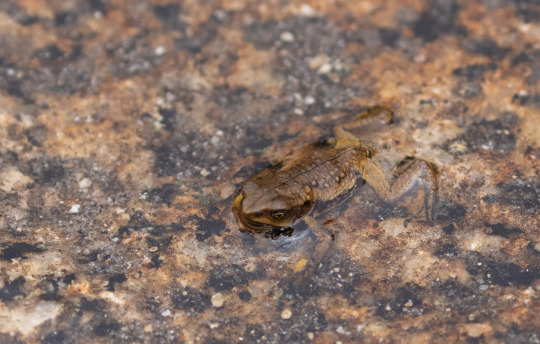
Tiny juvenile specimens of Guajira stubfoot toads [Atelopus carrikeri]. This species is endemic to the Sierra Nevada de Santa Marta mountain range in northern Colombia. They are critically endangered due to habitat loss and the spread of the chytrid fungus Batrachochytrium dendrobatidis. Once thought to be extinct, this toad was rediscovered after 14 years by a Project Atelopus team in early 2008. The individuals above were photographed by Jay McGowan.
#guajira stubfoot toad#stubfoot toad#harlequin toad#toad#frog#herps#amphibians#animals#toadlet#nature
227 notes
·
View notes
Text

today's funky frog of the day: the rio faisanes stubfoot toad (Atelopus coynei)!!!!!!!!!!!!!! endemic to ecuador and also unfortunately critically endangered, this frog is Looking Right At You! they were thought to be extinct for many years.
photo © mateoan
1K notes
·
View notes
Text

Cayenne stubfoot toad (Atelopus flavescens)
Photo by Daniel Heuclin
#Atelopus flavescens#Atelopus#cayenne stubfoot toad#toad#amphibians#animals#nature#wildlife#colorful toads#colorful amphibians#orange#orange toad#pink#pink toad
9 notes
·
View notes
Photo

Cayenne stubfoot toad (Atelopus flavenscens) in Saül, French Guiana
Julien NKS
1K notes
·
View notes
Text
Panamanian Golden Frog (Atelopus zeteki) – The Golden Life Frog

The Panamanian golden frog (Atelopus zeteki), also known as Cerro Campana stubfoot toad and other names, is a species of toad endemic to Panama. Panamanian golden frogs inhabit the streams along the mountainous slopes of the Cordilleran cloud forests of west-central Panama. While the IUCN lists it as Critically Endangered, it may in fact have been extinct in the wild since 2007.

Not me, but different skin as pretty maid (princess) in 19th century for captured this species as since in Play Together.
The remaining few specimens were taken into captivity and the location of filming was kept secret to protect them from potential poachers. Although captive populations seem to thrive well, reintroducing them to an area will not stop the threat of chytridiomycosis. No current remedies prevent or control the disease in the wild, but efforts are being made. One attempt was made to protect a wide variety of frogs from the disease by using the bacterium Janthinobacterium lividium that produces a chemical against the infections; however, the skin of Panamanian golden frogs was unsuitable for the bacterium used.
Individuals have been collected for breeding in captivity in a bid to preserve the species.
#ognimdo2002#earth responsibly#science fantasy#earth#ibispaint art#art ph#rapunzel's tangled adventure#frog#panama#panamanian golden frog#critically endangered#amphibian#animal#ibispaintx#april 2024#art philippines
2 notes
·
View notes
Text
Panamanian Golden Frog
also known as Cerro Campana stubfoot toad.
Is a species endemic to Panama.
Inhabit the streams alongside the mountainous slopes of the Cordilleran cloud forests of west-central Panama.
May have been endangered since 2007. Has been collected for breeding in captivity to try and preserve the species.
The species skin is toxic (glands on the skin produce tetrodotoxin and a unique compound called zetekitoxin). Skin contains enough toxins to kill 1,200 mice.
Instead of calling (to mate) like most male frogs they use visual displays (leg and head twitching, stamping the ground and hopping in place). Male frogs will wave and female frogs will wave back if interested.
Their estimated lifetime is 10-15 years.
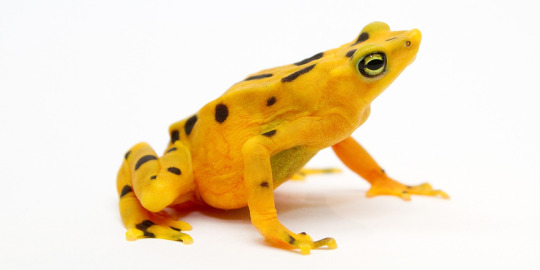
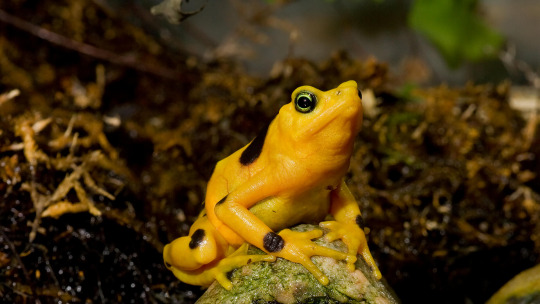
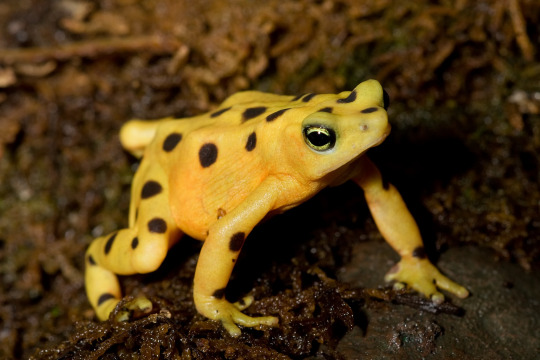
#panamanian golden frog#frog#jamesandfrogs#frogblr#frogs#stubfoot toad#cerro campana#yellow#toxic#spotted
31 notes
·
View notes
Video
Video: Pebas stubfoot toad, Atelopus spumarius by Andreas Kay
Via Flickr:
youtu.be/mjUCm79pDD8 from Ecuador
#amphibian#Andreas Kay#Anura#Atelopus spumarius#Bufonidae#Ecuador#Flickr#focus stack#frog#Jambato amazónico#Pebas stubfoot toad
633 notes
·
View notes
Text

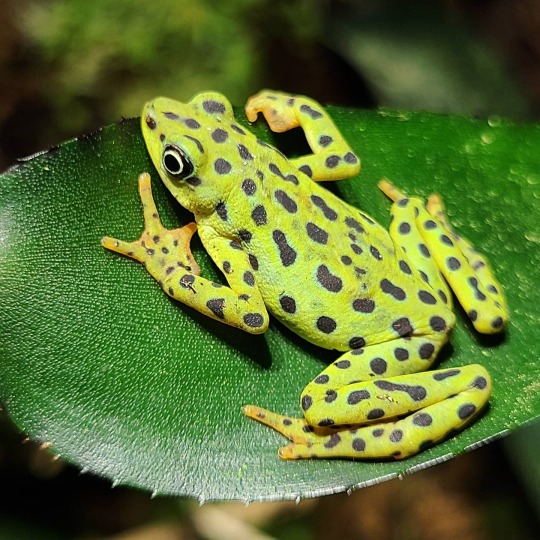
Rio Pescado Stubfoot Toad (Atelopus balios), family Bufonidae, endemic to SW Ecuador
CRITICALLY ENDANGERED.
Described in 1973, the species was rarely seen after that, and even thought extinct for awhile, until one was found again in 2011. Not many have been seen since then though. Zoos are working to help them recover.
Endangered due mainly to the chytrid fungus.
photograph by Nick Stacey
865 notes
·
View notes
Link
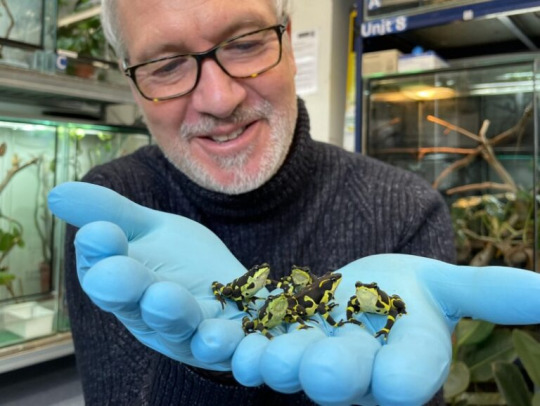
One of the world’s rarest toads has been successfully bred in captivity for the first time outside its country of origin by scientists at Manchester Museum, part of The University of Manchester .
The team recreated the exact conditions the critically endangered Variable Harlequin Toad – that lives in Panama in Central America- enjoy in the wild to achieve the success.
The breeding –the first outside Panama – is the culmination of 3 years of painstaking work since the 6 precious toad specimens – also known as Atelopus varius – arrived at the Museum in 2018 from the Central American country.
It is collaboration between Panama Wildlife Charity PWCC, Manchester Museum, and the Faculty of Medicine, Biology and Heath at The University of Manchester.
The work with the critically endangered toads are a key part of a project which combines non-invasive research and conservation education involving local communities in the Santa Fe National Park in Panama.
The Manchester Museum’s Vivarium team, who are world renowned experts in amphibian husbandry, mimicked the turbulent tropical stream with boulders and rocks, where the toad lays its eggs.
They monitored their amphibians’ native habitat closely to gain baseline data so they could recreate the correct temperatures, water levels, flow, and lighting. The special lighting allowed a specific species of tropical algae to grow in the museum’s aquarium, a key condition for successfully rearing of the tadpoles
Curator of Herpetology at the museum, Andrew Gray explained: “These rare toads usually live deep in the rainforest and only go to the streams to breed under very specific conditions, so it was vital we were able to recreate them. Tropical algae are the only things these tadpoles eat off submerged rocks, because they have specialised, sucker-like mouthparts. So it was essential we were able to grow it in the aquarium.
“The adults can stay underwater for very long periods before breeding and were in the aquarium for over a month. We were very nervous about putting them in such deep water but they walked along the bottom just like they were walking on land; it was unbelievable.”
The museum was invited by the Panamanian authorities to keep and breed the toads to highlight their conservation needs and provide a back-up population in case they become extinct.
Continue reading: https://www.miragenews.com/toad-breeding-success-is-world-522375/
Donate to Panama Wildlife Conservation: https://panamawildlife.org/donate/
#american#amphibians#biodiversity#central#community#harlequin toad#harlequin frog#stubfoot toad#stubfoot frog#atelopus#atelopus varius#panama#news#science news#mirage#mirage news#conservation
2K notes
·
View notes
Text
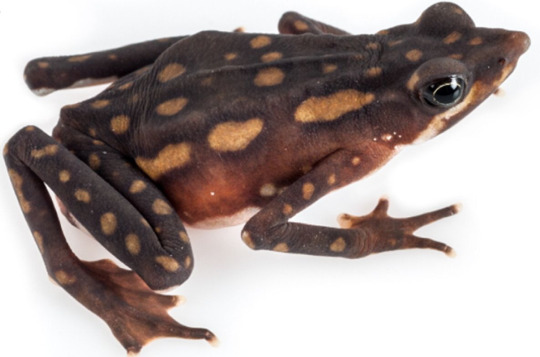
today's funky frog of the day: the scrawny stubfoot toad (Atelopus longirostris)! not only is this friend super adorable, they also have an amazing story! between 1989 and 2016, this frog was considered to be extinct. however, in 2016, they found more specimens and a breeding program was established in the hopes of replenishing the population!
photo by Luis Aurelio Coloma
#scrawny stubfoot toad#IM SO GLAD HE IS NO LONGER CONSIDERED EXTINCT#HEHEHHE#Atelopus longirostris#funky frog of the day
580 notes
·
View notes
Photo

Trying out gouache, painted some small frog portraits
Left to right, top to bottom:
European tree frog, mexican burrowing frog, strawberry poison dart frog, red-eyed leaf frog, african bullfrog, blue poison dart frog, rain frog, ornate burrowing frog, polkadot treefrog, amazonian poison dart frog, Fleischmann’s glass frog, amazon horned frog, crucifix frog, ruby poison dart frog, Pebas stubfoot toad, tomato frog
#frog#grogs#toad#amphibian#portraits#gouache#painting#poison dart frog#tree frog#burrowing frog#leaf frog#bullfrog#rain frog#glass frog#horned frog
71 notes
·
View notes
Text

Green mosaic harlequin frog (Atelopus cruciger)
Photo by Stephen Dalton
#frog#green mosaic harlequin frog#rancho grande harlequin frog#harlequin frog#veragua stubfoot toad#toad#atelopus#atelopus cruciger#amphibians#bufonidae#venezuela#venezuelan wildlife#tropical frogs#tropical#animals#wildlife#yellow#yellow frogs#yellow and black#nature
33 notes
·
View notes
Photo

359 notes
·
View notes
Text
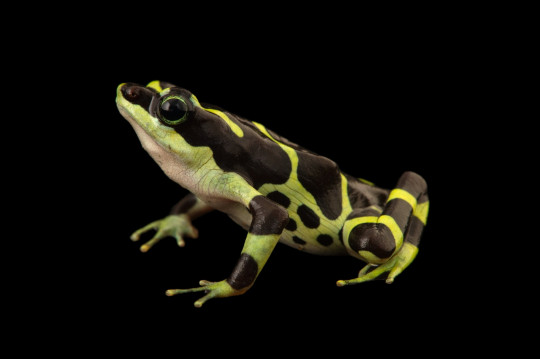
Condoto stubfoot toad (Atelopus spurrelli) at the Cali Zoo in Colombia
2 notes
·
View notes
Text
atelopus zeteki, Common names: Panama golden frog, Cerro Campana stubfoot toad, Zetek’s golden frog
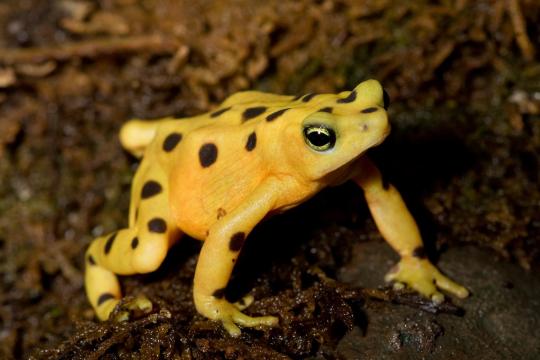
(image source)
Habitat: In vegetation surrounding streams in tropical forests
Found in: Central America
Fun fact(s): Often communicate with other frogs through hand gestures. This is rare not just for frogs but for most animals. They likely developed this because the streams they live along tend to be too loud to hear their calls over.
They have both “frog” and “toad” in their different common names, but officially they are considered toads, and are in fact true toads (bufonidae family)!
They are poisonous, and can kill small animals with said poison.

(Image source)
#GENUS: atelopus (harlequin toads)#harlequin toads#toads#FAMILY: Bufonidae (true toads)#true toads#frog of the day#poisonous frogs
41 notes
·
View notes